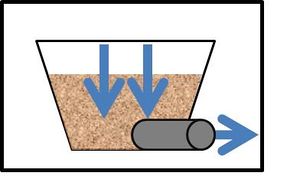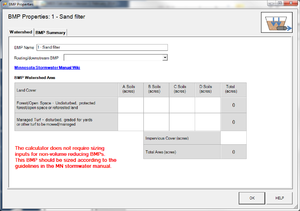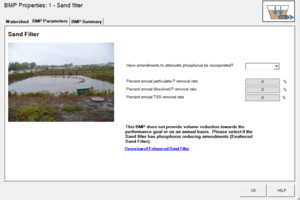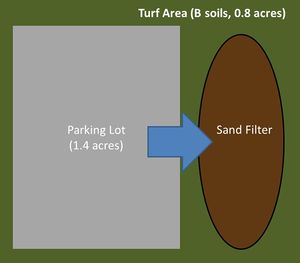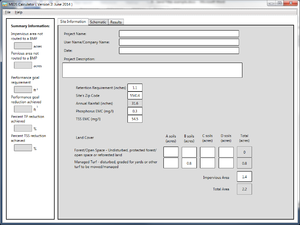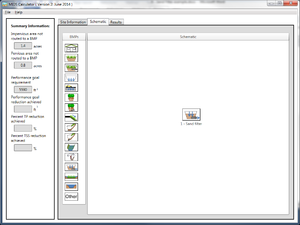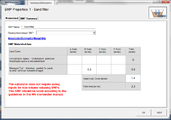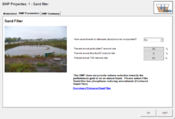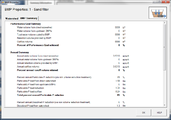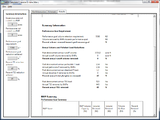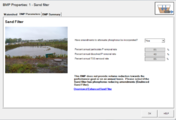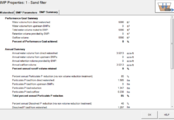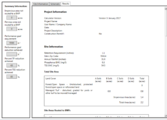
Requirements, recommendations and information for using sand filter as a BMP in the MIDS calculator
A sand filter does not reduce stormwater volume. While this BMP does not provide stormwater volume reduction toward the performance goal or on an annual basis, it does provide annual pollutant load reductions. Version 3 of the calculator provides an option to add an amendment to attenuate dissolved phosphorus.
Contents
Changes to Version 4 of the MIDS Calculator
- The USER must enter a bypass percent for this BMP. See the guidance for determining bypass percent.
- The user is asked to select a design level from a dropdown. These are explained below.
- When the user is asked if an amendment is added, a dropdown menu appears with the following options:
- No
- Tier 1
- Tier 2
- The selection affects the percent of dissolved phosphorus removed by the practice. Removal, as a percent, is 0, 40, and 60 of the total dissolved phosphorus for No amendment, Tier 1, and Tier 2, respectively.
MIDS calculator user inputs for sand filter
For the sand filter BMP, BMP watershed areas is the only required design parameter.
- Watershed tab
- BMP Name: this cell is auto-filled but can be changed by the user.
- Routing/downstream BMP: if this BMP is part of a treatment train and water is being routed from this BMP to another BMP, the user selects the name of the BMP from the dropdown box to which water is being routed. All water must be routed to a single downstream BMP. Note that the user must include the BMP receiving the routed water in the Schematic or the BMP will not appear in the dropdown box.
- BMP Watershed Area: BMP watershed areas are the areas draining directly to the BMP. Values can be added for four soil types (Hydrologic Soil Groups (HSG) A, B, C, D) and for three Land Cover types (Forest/Open Space, Managed Turf and impervious). The surface area of the BMP should be included as a managed turf land cover under the hydrologic soils group of the native soils located under the BMP. Units are in acres.
- BMP Parameters tab
- Amendments: The user must answer "Yes" or "No" to the question "Have amendments to attenuate phosphorus been incorporated?"
- BMP Summary Tab: The BMP Summary tab summarizes the volume and pollutant reductions provided by the specific BMP. It details the performance goal volume reductions and annual average volume, dissolved P, particulate P, and TSS load reductions. Included in the summary are the total volume and pollutant loads received by the BMP from its direct watershed, from upstream BMPs and a combined value of the two. Also included in the summary, are the volume and pollutant load reductions provided by the BMP, in addition to the volume and pollutant loads that exit the BMP through the outflow. This outflow load and volume is what is routed to the downstream BMP if one is defined in the Watershed tab. Finally, percent reductions are provided for the percent of the performance goal achieved, percent annual runoff volume retained, total percent annual particulate phosphorus reduction, total percent annual dissolved phosphorus reduction, total percent annual TP reduction, and total percent annual TSS reduction.
Methodology
Required Treatment Volume
The required treatment volume, or the volume of stormwater runoff delivered to the BMP, equals the performance goal (1.1 inches or user-specified performance goal) times the impervious area draining to the BMP. This stormwater is delivered to the BMP instantaneously.
Volume Reduction
This BMP does not provide volume reduction towards the performance goal.
Pollutant Reduction
Pollutant load reductions are calculated on an annual basis. A sand filter does not provide annual volume reduction. Removal of TSS and particulate phosphorus (PP) are affected by the choice of design level.
- Level 1: TSS removal = 75%, PP removal = 41%
- Provides less than full water quality volume treatment, or
- Pretreatment less than 25% of water quality volume, or
- Filter bed is less than 5% of contributing drainage area
- Level 2: TSS removal = 85%, PP removal = 47%
- Provides full water quality volume treatment, and
- Pretreatment 25% or more of water quality volume, and
- Filter bed > 5% of contributing drainage area
- Level 3: TSS removal = 90%, PP removal = 50%
- Exceeds water quality volume by more than 50%, and
- Pretreatment 25% or more of water quality volume, and
- Filter bed > 10% of contributing drainage area
Removal of dissolved phosphorus (DP) varies with the user selection from a dropdown list.
- No amendment added to attenuate P; DP removal = 0%
- Tier 1: Amendment added and meets the following; DP removal = 40%
- Iron enhanced system, and
- Iron 5-8% by weight, high purity iron (90%+ elemental iron) with little or no toxic impurities (e.g., copper, cadmium, lead, etc.), and reactive with phosphate, and
- Inspect IESFs at least once annually, with more frequent inspections (monthly or quarterly) during the first 1-2 years if needed to ensure construction was successful (see Assessing the performance of iron enhanced sand filter), and
- Annually or as needed remove vegetation and accumulated sediment (as needed, typically after a storm greater than 1 in of precipitation), and
- Rake surface with a steel-tipped rake to break up oxidized iron clumps or crust that may form, and
- System designed to allow drying (e.g. exposed to sunlight and access to air through drain tile)
- Level spreader, modified pond inlets, or other method or design for spreading water across the system, and
- Enhanced pretreatment designed to remove organic material (see Pretreatment Practice Selection Tool to identify practices effective at removing debris and solids), and
- Designed to be offline such that flows beyond the water quality volume flows are diverted around the system, and
- Inspection and maintenance agreement established that identifies the entity responsible for inspection and maintenance.
- Tier 2: Determined from water quality monitoring. See Assessing the performance of iron enhanced sand filter.
The default is no amendment.
NOTE: The user can modify event mean concentrations (EMCs) on the Site Information tab in the calculator. Default concentrations are 54.5 milligrams per liter for total suspended solids (TSS) and 0.3 milligrams per liter for total phosphorus (particulate plus dissolved). The calculator will notify the user if the default is changed. Changing the default EMC will result in changes to the total pounds of pollutant reduced.
Routing
A sand filter can be routed to any other BMP, except for a green roof and a swale side slope or any BMP in a stormwater treatment sequence that would cause stormwater to be rerouted back to the sand filter already in the sequence. All BMPs can be routed to a sand filter except for a swale side slope.
Assumptions for sand filter
The following general assumption applies in calculating the credits for a sand filter. If this assumption is not followed, the pollutant reduction credits cannot be applied.
- The sand filter has been properly designed, constructed and will be properly maintained according to specifications for filtration systems.
On the watershed tab, the following warning is given:
“The calculator does not require sizing inputs for non-volume reducing BMPs. This BMP should be sized according to the guidelines in the MN stormwater manual.” Design and construction criteria can be found at this link.
Sand Filter Example
This example was completed using Version 3 of the Calculator.
A sand filter is to be constructed in a watershed that contains a 1.4 acre parking lot surrounded by 0.8 acres of pervious area (Turf area). All of the runoff from the watershed will be treated by the sand filter. The soils across the area have a unified soils classification of SM (HSG type B soil). The following steps detail how this system would be set up in the MIDS calculator.
Step 1: Determine the watershed characteristics of your entire site. For this example we have a 2.2 acre site with 1.4 acres of impervious area and 0.8 acres of pervious turf area in type B soils. The pervious area includes the area of the sand filter.
Step 2: Fill in the site specific information into the Site Information tab. This includes entering a Zip Code (55414 for this example) and the watershed information from Step 1. Zip code and impervious area must be filled in or an error message will be generated. Other fields on this screen are optional.
Step 3: Go to the Schematic tab and drag and drop the Sand Filter icon into the Schematic Window.
Step 4: Open the BMP properties for the Sand filter by right clicking on the Sand filter icon and selecting Edit BMP properties, or by double clicking on the Sand filter icon.
Step 5: If help is needed, click on the Minnesota Stormwater Manual Wiki link or the Help button to review input parameter specifications and calculation specific to the Sand filter BMP.
Step 6: Determine the watershed characteristic for the sand filter. For this example the entire site is draining to the sand filter. The watershed parameters therefore include a 2.2 acre site with 1.4 acres of impervious area and 0.8 acres of pervious turf area in type B soils. There is no routing for this BMP. Fill in the BMP specific watershed information (1.4 acres on impervious cover and 0.8 acres of Managed turf in B soils).
- MIDS calculator screen shots for inputs for sand filter. Click on an image for enlarged view.
Step 7: Go to the BMP Parameters tab and answer the question "Have amendments to attenuate phosphorus been incorporated?". For this example, answer "No". Design parameters are not required for the sand filter BMP.
Step 8: Click on BMP Summary tab to view results for this BMP.
Step 9: Click on the OK button to exit the BMP properties window
Step 10: Click on the Results tab to see overall results for the site.
Add an amendment to attenuate phosphorus
In Step 7 above, answer "Yes", then complete Steps 8, 9, and 10. Note the removal of dissolved phosphorus and the associated increased removal of total phosphorus.
- MIDS calculator screen shots for inputs for sand filter with amendment added to attenuate phosphorus. Click on an image for enlarged view.
Information
- Construction specifications for filtration BMPs
- Information on operation and maintenance of filtration BMPs.
Links to MIDS pages
- Overview of Minimal Impact Design Standards (MIDS)
- Performance goals for new development, re-development and linear projects
- Design Sequence Flowchart-Flexible treatment options
- Community Assistance Package
- MIDS calculator
- Performance curves for MIDS calculator
- Training and workshop materials and modules
- Technical documents
This page was last edited on 23 December 2022, at 01:30.
